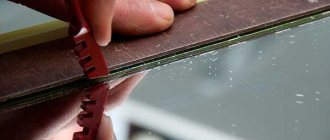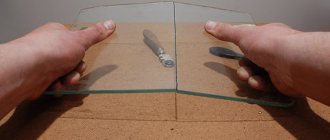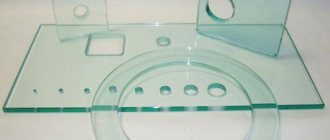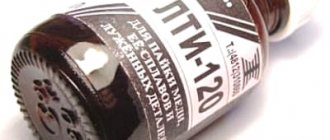In any apartment you may be faced with the need to replace glass in a window, door or closet. It is very rare to find ready-made glass of the required size. Of course, you can turn to a specialist for help, but this will take time and money. All the necessary work can be done with your own hands at home if you know how to cut glass correctly.
How to choose the right glass
Glassmakers advise when choosing glass to pay attention to the following points:
- One of the signs of high-quality glass is a blue or greenish tint to its ends.
- Scratched sheets should not be used.
- If all the rules are not followed during the process of rolling glass or cooling it, then such sheets may have defects in the form of stripes. These stripes will significantly distort the image, so it is better not to use such sheets to replace glass in a window.
- The thickness of the glass depends on the size of the frame into which it is inserted. If its width and height are less than 600 mm, then you can get by with glass 2–2.5 mm thick. And if one of these parameters exceeds 600 mm, then the thickness of the glass sheet increases to 3.5–4 mm.
- When doing glazing at home, you need to cut a piece of glass 3–5 mm smaller than the size of the frame, because the slightest distortion will not allow the glass to be inserted into the opening.
Possible mistakes
Most often, inexperienced carvers make the following erroneous actions:
- When cutting corrugated glass, they do not use a roller tool, but a different model of glass cutter. In addition, frosted glass with patterns and grooves is not cut from the smooth side;
- The dimensions of the final workpieces are often not respected. Trimming should be done in such a way that the dimensions are a couple of millimeters smaller than the frame into which the glass is planned to be inserted;
- when working with a glass cutter, additional materials are ignored - patterns, which are special rulers;
- It is recommended to ensure that the glass cutter is suitable for use before each cut. To do this, its sharpness is checked - a piece of glass is cut off on already cut pieces. If during cutting you hear an unpleasant creak, the cutting edge needs to be sharpened.
The glass cutter must be checked before each cut.
Glass preparation
Often many people simply forget about this important point. But high-quality glass cutting with your own hands is impossible without preliminary preparation. New glass should be wiped with a damp cloth. After it dries, wipe dry.
Some experts recommend using newspaper rather than a rag. It will not leave lint on the glass that could interfere with the movement of the glass cutter.
Glass that has already been used cuts much worse and requires more careful preparation. They are washed using special detergents, and after drying, degreased with turpentine or kerosene. During the drying process, it is necessary to prevent dust from entering the sheet.
Useful tips
- If there is a need to make a hole or carefully cut glass, and then give it a round shape, you will only need specialized tools and knowledge of your craft.
- For any work, you need to thoroughly wash and degrease the surface with acetone or gasoline and rinse with plain water. If you can’t clean the surface with liquid, you can take a slice of potato, rub it on the product and wipe it thoroughly with a dry cloth.
- In the place where you need to make a hole, no matter how thick the glass is, you need to pour a handful of sea sand, make a depression of the required diameter in it, and then pour molten tin or lead into the hole and let it cool. Then you need to remove the solder and remove any remaining sand.
- Before cutting, be sure to degrease the glass where the glass cutter will pass. Then the sheet is attached with a suction cup and a metal rod is installed.
Checking tools and arranging the workplace
Before discussing how to properly cut glass, you need to decide on the tool that will be used for this specific job. In order to cut a glass sheet with your own hands, a glass cutter is most often used. There are three types of glass cutters:
- roller;
- diamond;
- oil
The last two are used mainly by professionals. The cheapest and most common option is a glass cutter with replaceable rollers.
Regardless of the model used, before cutting glass, it is better to check the sharpness of the glass cutter. To do this, you can try cutting some unnecessary piece of glass. Ideally, the glass cutter should move with a slight rustle, leaving a thin, continuous line. If it moves with a creak, the cut line is interrupted or looks like a white scratch, then either the cutting element is dull or errors were made in the cutting technique.
It is also necessary to prepare a flat surface, the dimensions of which must exceed the dimensions of the sheet being cut. At home, this could be a table covered with a soft cloth. If the table is not large enough, you can put a sheet of plywood or chipboard on top of it. You will also need a marker and tape measure for marking. If the glass will be cut with a glass cutter, then you need to prepare a thick metal ruler. Its thickness should be 8–10 mm - this is the only way you will create the necessary support for the cutting tool.
Features of working with non-standard glass
Tempered glass cannot be processed at home; when mechanical stress is applied to it, it crumbles or breaks into pieces. Corrugated - cut with a glass cutter in the same way as a regular one, but on the smooth side.
Acrylic glass is not actually glass. Thin material is cut using simple scissors or an ordinary knife. A thick sheet can be drawn along a ruler with a piece of a hacksaw blade, several times, and then bent and broken along the groove line.
How to use a glass cutter correctly
To cut glass with your own hands, you must follow the technology and sequence of actions.
- The starting and ending points of the cut are marked on the sheet.
- Place the glass cutter at the starting point and attach a ruler to it.
Note! The ruler should not be located along the cut line, but at a distance of several millimeters from it. This value corresponds to the distance between the tip of the glass cutter and its side surface.
- The cut is carried out smoothly, from start to finish in one movement and with one effort. And only once. If you run a glass cutter over one place several times, the glass will simply crack.
- The cut piece is chipped. To do this, the cut line is aligned with the edge of the table. They cause a crack by lightly tapping the cut with a glass cutter, and then break it off in one motion.
- If the chip is uneven, then excess glass can be removed with pliers or using special cutouts in the handle of the glass cutter. To avoid cracking, the cut line should be lightly moistened with turpentine or kerosene.
- At the final stage, the cut line is processed with sandpaper, a velvet file or a grindstone.
How else can you cut glass?
What to do if you don’t have a glass cutter at hand? There are ways in which glass is cut with non-standard tools. This operation can be carried out with a soldering iron, grinder, nichrome thread and even ordinary scissors! Let's find out how to properly cut glass with your own hands using each of these methods.
- Using a soldering iron. First, cuts are made with a file at the beginning and end of the cutting line. Then you need to carefully run a well-heated soldering iron along the entire line. Due to the temperature difference on the sides of the surface, the glass will crack, after which all that remains is to carefully break it off.
- Bulgarian. This tool is found in almost every home, so it is not surprising that it has also been adapted for working with glass. In order to cut glass with a grinder, you will need a thin diamond disc. With its help, a thin groove is made along the entire cutting line, along which later chipping occurs. But when cutting with a grinder, you need to make sure that the glass does not overheat, and be sure to use coolant. You need a good tool, otherwise the glass will simply shatter from its vibration. When working with an angle grinder on glass, it is imperative to protect your respiratory organs and eyes. Getting the smallest glass dust into them will not lead to anything good. Therefore, if you cut a sheet of glass with a grinder, you need to stock up on glasses and a respirator.
- Using heating and cooling. A thread soaked in a flammable substance is laid along the cutting line and set on fire. Immediately after it goes out, the cutting line is cooled with water. A sudden temperature change will cause the glass to crack. Another option is to heat the glass with a nichrome thread through which an electric current passes. In this case, no water is required, the temperature difference between the two surfaces of the sheet is sufficient.
- Scissors. Thin glass up to 3 mm can be cut with ordinary tailor's scissors, if this operation is performed by immersing the scissors and glass in a container of hot water. The process feels like cutting thick cardboard.
Shaped cutting of mirrors
Various shapes from this material can be prepared either with a special device or with a homemade “glass-cutter pencil” made from charcoal. The prepared powder is mixed with gum arabic (the transparent viscous liquid secreted by acacia forms a sticky solution upon contact with water). The resulting dough is rolled into large sticks and thoroughly dried.
Before starting work, the edge of the glass is filed with a triangular file. Next, the pencil is lit and the treated end is touched with it. The hot end is pointed in the required direction. The cracks that have formed cause the mirror to easily burst. It is important that all movements must be performed exclusively on the front part of the surface.
Tempered glass processing
The question often comes up on forums: how to cut tempered glass? The answer is simple: tempered glass cannot be cut or drilled. Whenever you try to do this, it loses all its properties and simply shatters into small pieces. Tempered glass was used in cars before triplex technology was invented. During the accident, glass fragments should not have injured passengers. So you shouldn’t even try to cut tempered glass with any tool.
To understand how to cut glass with your own hands, you just need to take it and try it. The choice of method depends on individual skills and the availability of the necessary tools. But all these options are quite feasible at home.
Safety regulations
When starting the procedure for cutting glass, be sure to keep in mind that working with this material requires compliance with safety rules, which are not recommended to be neglected. When untreated, glass has sharp edges that can easily cut the skin and cause infection. To avoid cuts, protect your hands with gloves and wear clothes with sleeves. Since glass tends to crumble into small, sharp fragments, we strongly recommend cutting with glasses.
The glass cutting area must be level and stable. It is strictly not recommended to perform this operation on a knee, a rickety stool, or other questionable surfaces. Compliance with this rule will minimize the risk of glass falling onto the floor, and will also make the work more convenient and improve the quality of the cut.
If you have not previously had experience in handling glass, and do not yet know how to cut with a glass cutter, we do not recommend neglecting the above recommendations. Perhaps some experienced craftsmen can do this work with their eyes closed on their knees, but for beginners everything usually does not go so smoothly. Due to inexperience, you can make many mistakes: grab a sharp edge, drop the glass on your foot, or crush the cut site and get a piece of glass in your eye. If you are working with glass for the first time, and have not yet experienced this process, it is best to be fully prepared.











